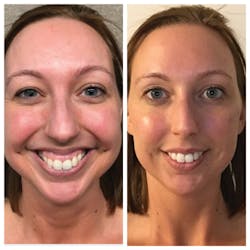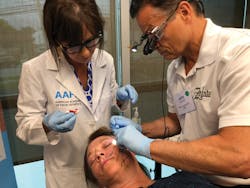Be happy
Louis Malcmacher, DDS, MAGD
Are dentists happy practicing dentistry and with their practices? Let’s take a look at what the data shows.
First, we’ll look at an excellent article, “Practice ownership is declining” by Marko Vujicic, PhD, chief economist and vice president of the American Dental Association Health Policy Institute.1 His data and studies are valuable resources for all dental professionals.
Dr. Vujicic writes, “Overall, 80% of dentists in private practice are owners, according to the data. [. . .] Practice ownership rates in dentistry are declining slowly and steadily. They are declining for almost every age group.”
Dr. Vujicic continues, “The ability to own their own practices is one of the top three factors attracting dentists to dentistry, and most of [sic] dental school graduates intend to work in private practice. All else being equal, owner dentists earn more, although overall career satisfaction differences are not clear-cut.”
A patient treated with Botox, dermal fillers, and PDO threadlifts displays proper lip and smile lines and improved dentofacial esthetics.
Dr. Vujicic ends his article with the suggestion that dentists might be moving away from private practice ownership because they prefer the clinical side of dentistry to the practice management part. I agree with this point; running a dental practice is hard work, and it is something dentists are not trained for and often do not enjoy. But I think that it goes deeper than this—I think it involves the clinical side of dentistry too.
To me, the amazing thing about the study described in Dr. Vujicic’s article is that 80% of dentists still choose private practice. Let’s face it: despite our best efforts, even with all of the new treatment options and technology available, most patients hate going to the dentist. We all knew this when we chose this profession because we are a very dedicated group of health professionals who really want to help patients. Clinical dentistry is technically challenging, and it can cause physical stress for clinicians. When you combine that with practice management, owning a dental practice can take a toll emotionally.
I have trained thousands of dental professionals in facial injectables, such as Botox, dermal fillers, and polydioxanone (PDO) threadlifts, through the American Academy of Facial Esthetics. The comment we most often receive from members is that the training has given them a new look at their practices with procedures that patients desire and are happy to receive and pay for. Many dentists report that adding these procedures to their practices has dramatically increased their production and provided their patients with esthetic outcomes they love.2
American Academy of Facial Esthetics faculty member Suzanne Haley, DMD, PC, mentors a dentist learning to provide a solid filler PDO threadlift.
I recently spoke to a dentist who explained why he added facial injectables to his practice: “I am a dentist, and I have a friend who is a nurse practitioner who was opening a medical spa office in the next building. The office wasn’t finished, and she asked if she could see patients in one of my treatment rooms for two days a week until her new office was ready. I was happy to help out. One day, I was doing some restorative dentistry on a patient who was a little difficult. The patient wasn’t happy, and neither was I. The nurse practitioner was treating patients with Botox and dermal fillers in another room. They were joking, laughing, and happy, and the patient was happy to pay the nurse! That is when the lightbulb went on for me, and I decided I had to add this to my practice. That is why I got trained in facial injectables.”
Happiness comes from loving what you do. Sometimes the challenges of running an office and providing clinical dentistry can wear us down. Adding exciting, highly desirable procedures, such as Botox and dermal fillers, to your practice mix adds a whole new dimension to your practice with procedures you and your patients will love. Learn to love your practice again. Get trained today!
References
1. Vujicic M. Practice ownership is declining. J Am Dent Assoc. 2017;148(9):690-692.
2. Malcmacher L. When less is more. Dental Economics website. https://www.dentaleconomics.com/articles/print/volume-108/issue-7/practice/when-less-is-more.html. Published July 1, 2018. Accessed August 1, 2018.
Author’snote: Go to facialesthetics.org to sign up for a free monthly e-newsletter or for information about live-patient Botox and dermal fillers training, PDO threadlifts, frontline TMJ and orofacial pain training, bruxism therapy, and dental sleep medicine.
Louis Malcmacher, DDS, magd, is a practicing general dentist and an internationally known lecturer and author. He is president of the American Academy of Facial Esthetics (AAFE) and serves as a consultant to STATDDS. Contact him at (800) 952-0521 or [email protected].


